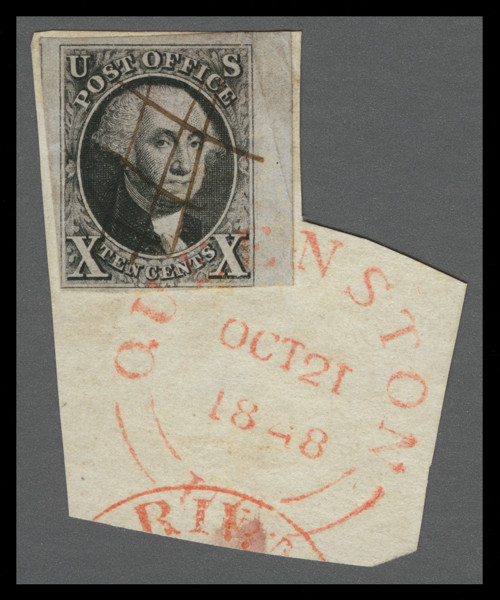
# MA1625 - 1847 10c Wash.#2 on Cover, to Canada
U.S. #2
1847 10¢ Washington
Quantity issued: 863,800 (estimate)
First Day of Issue: July 1, 1847
Printed by: Rawdon, Wright, Hatch & Edison
Printing Method: Flat plate
Watermark: None
Perforation: Imperforate
Color: Black
In a cameo portrait surrounded by leaves, this stamp depicts the Father of our Country, George Washington. As a Revolutionary War hero, he led the Continental Army to a glorious victory, delivering America from Britain's rule and granting our nation the freedom it still enjoys. In 1789, he was inaugurated as the first President of the United States. When the United States issued its first adhesive postage stamps, Washington was a natural choice to be pictured on the 10¢ denomination.
The First U.S. Postage Stamps
In the 1840s, United States postal authorities were carefully watching the world’s reaction to Great Britain’s Penny Black, the first adhesive postage stamp. An adhesive stamp was being considered for use in the U.S. When Robert H. Morris, postmaster of New York, proposed issuing a provisional stamp, there were no objections.
Morris assumed the printing cost, and in 1845, the first U.S. postmaster’s provisional was issued. Other postmasters followed suit, providing their own distinct stamps for pre-payment of mail.
Two years later, the U.S. Post Office Department tried its own government-issued stamp. Rates were determined by the weight and distance the letter was being mailed. Letters mailed a distance of 300 miles or less were 5¢ per half ounce, while those mailed over 300 miles were 10¢ per half ounce. Postage could be paid by the sender at the time the letter was mailed, or by the addressee upon receipt.
When postage was paid by the sender, the letter was marked “paid” by pen and ink or hand stamped. If no such cancel was evident, the person receiving the letter paid the postage. Inspections for accuracy and records of postal revenues were virtually impossible. With pre-printed stamps, accurate records could be kept of how many were issued and sold. It wasn’t until 1855 that the use of postage stamps became mandatory.
A contract was awarded to a firm of bank note engravers for the printing of the 5¢ and 10¢ stamps. The stamps were to be available in major post offices on July 1, 1847. Due to delays in production, only one office, New York City, received the stamps on that date. The stamps were produced until 1851.
Reproductions (official imitations) of both stamps were printed by the Bureau of Engraving and Printing. (They were invalid for postage.) Differences from originals include: Line of the mouth is straighter, eyes appear “sleepy,” engraver’s initials at bottom of stamps are fainter.
U.S. #2
1847 10¢ Washington
Quantity issued: 863,800 (estimate)
First Day of Issue: July 1, 1847
Printed by: Rawdon, Wright, Hatch & Edison
Printing Method: Flat plate
Watermark: None
Perforation: Imperforate
Color: Black
In a cameo portrait surrounded by leaves, this stamp depicts the Father of our Country, George Washington. As a Revolutionary War hero, he led the Continental Army to a glorious victory, delivering America from Britain's rule and granting our nation the freedom it still enjoys. In 1789, he was inaugurated as the first President of the United States. When the United States issued its first adhesive postage stamps, Washington was a natural choice to be pictured on the 10¢ denomination.
The First U.S. Postage Stamps
In the 1840s, United States postal authorities were carefully watching the world’s reaction to Great Britain’s Penny Black, the first adhesive postage stamp. An adhesive stamp was being considered for use in the U.S. When Robert H. Morris, postmaster of New York, proposed issuing a provisional stamp, there were no objections.
Morris assumed the printing cost, and in 1845, the first U.S. postmaster’s provisional was issued. Other postmasters followed suit, providing their own distinct stamps for pre-payment of mail.
Two years later, the U.S. Post Office Department tried its own government-issued stamp. Rates were determined by the weight and distance the letter was being mailed. Letters mailed a distance of 300 miles or less were 5¢ per half ounce, while those mailed over 300 miles were 10¢ per half ounce. Postage could be paid by the sender at the time the letter was mailed, or by the addressee upon receipt.
When postage was paid by the sender, the letter was marked “paid” by pen and ink or hand stamped. If no such cancel was evident, the person receiving the letter paid the postage. Inspections for accuracy and records of postal revenues were virtually impossible. With pre-printed stamps, accurate records could be kept of how many were issued and sold. It wasn’t until 1855 that the use of postage stamps became mandatory.
A contract was awarded to a firm of bank note engravers for the printing of the 5¢ and 10¢ stamps. The stamps were to be available in major post offices on July 1, 1847. Due to delays in production, only one office, New York City, received the stamps on that date. The stamps were produced until 1851.
Reproductions (official imitations) of both stamps were printed by the Bureau of Engraving and Printing. (They were invalid for postage.) Differences from originals include: Line of the mouth is straighter, eyes appear “sleepy,” engraver’s initials at bottom of stamps are fainter.











